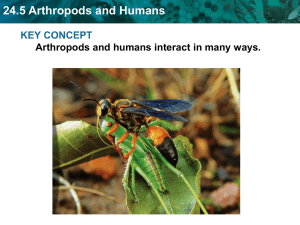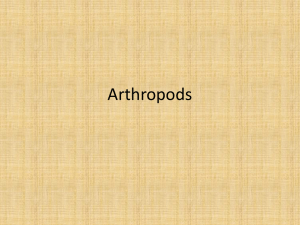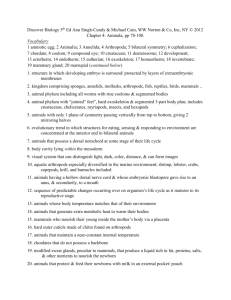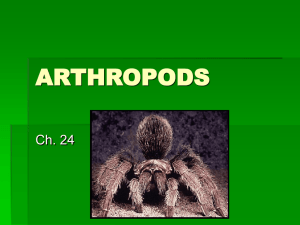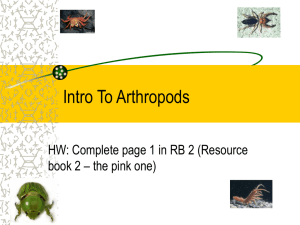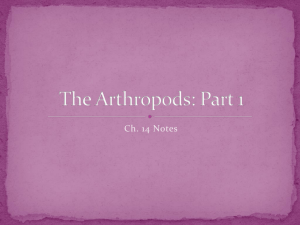Biol 11
advertisement
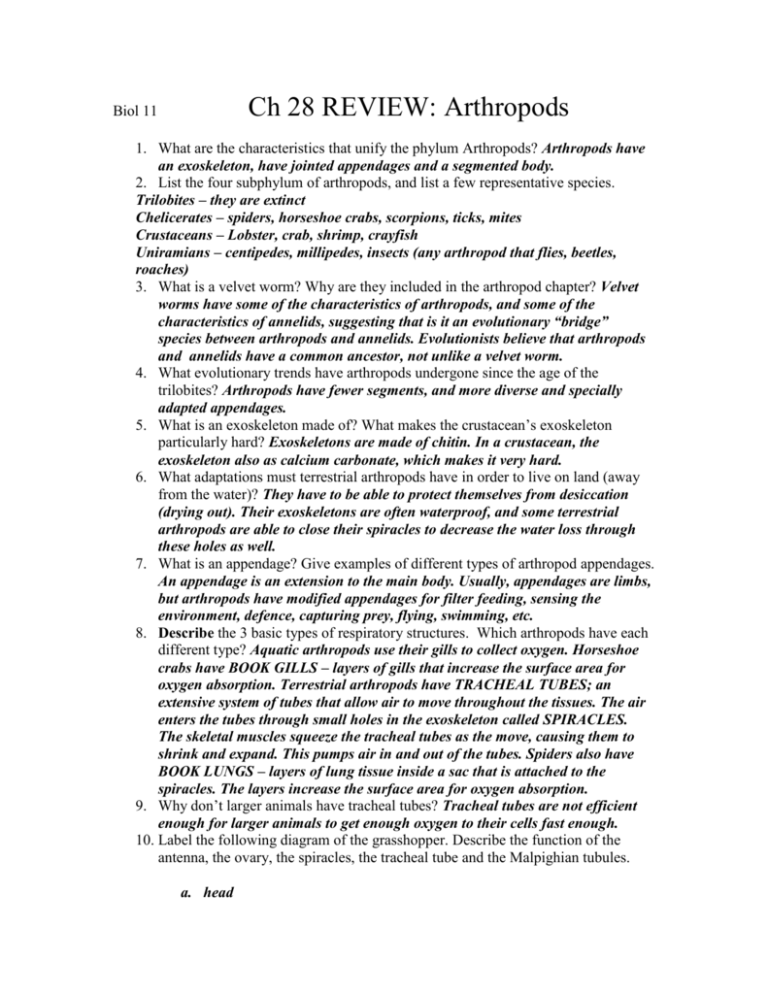
Ch 28 REVIEW: Arthropods Biol 11 1. What are the characteristics that unify the phylum Arthropods? Arthropods have an exoskeleton, have jointed appendages and a segmented body. 2. List the four subphylum of arthropods, and list a few representative species. Trilobites – they are extinct Chelicerates – spiders, horseshoe crabs, scorpions, ticks, mites Crustaceans – Lobster, crab, shrimp, crayfish Uniramians – centipedes, millipedes, insects (any arthropod that flies, beetles, roaches) 3. What is a velvet worm? Why are they included in the arthropod chapter? Velvet worms have some of the characteristics of arthropods, and some of the characteristics of annelids, suggesting that is it an evolutionary “bridge” species between arthropods and annelids. Evolutionists believe that arthropods and annelids have a common ancestor, not unlike a velvet worm. 4. What evolutionary trends have arthropods undergone since the age of the trilobites? Arthropods have fewer segments, and more diverse and specially adapted appendages. 5. What is an exoskeleton made of? What makes the crustacean’s exoskeleton particularly hard? Exoskeletons are made of chitin. In a crustacean, the exoskeleton also as calcium carbonate, which makes it very hard. 6. What adaptations must terrestrial arthropods have in order to live on land (away from the water)? They have to be able to protect themselves from desiccation (drying out). Their exoskeletons are often waterproof, and some terrestrial arthropods are able to close their spiracles to decrease the water loss through these holes as well. 7. What is an appendage? Give examples of different types of arthropod appendages. An appendage is an extension to the main body. Usually, appendages are limbs, but arthropods have modified appendages for filter feeding, sensing the environment, defence, capturing prey, flying, swimming, etc. 8. Describe the 3 basic types of respiratory structures. Which arthropods have each different type? Aquatic arthropods use their gills to collect oxygen. Horseshoe crabs have BOOK GILLS – layers of gills that increase the surface area for oxygen absorption. Terrestrial arthropods have TRACHEAL TUBES; an extensive system of tubes that allow air to move throughout the tissues. The air enters the tubes through small holes in the exoskeleton called SPIRACLES. The skeletal muscles squeeze the tracheal tubes as the move, causing them to shrink and expand. This pumps air in and out of the tubes. Spiders also have BOOK LUNGS – layers of lung tissue inside a sac that is attached to the spiracles. The layers increase the surface area for oxygen absorption. 9. Why don’t larger animals have tracheal tubes? Tracheal tubes are not efficient enough for larger animals to get enough oxygen to their cells fast enough. 10. Label the following diagram of the grasshopper. Describe the function of the antenna, the ovary, the spiracles, the tracheal tube and the Malpighian tubules. a. head b. c. d. e. f. g. thorax abdomen wings heart spiracles – allow air into the tracheal tubes Malpighian tubules – collect nitrogenous wastes from the blood in the sinuses and add it to the solid waste for excretion h. Tracheal tube – allows air to circulate throughout the cells for oxygen/carbon dioxide exchange i. Walking legs j. Digestive tract k. Compound eye l. Antennae – senses the environment; has chemoreceptors for tasting/smelling and sense receptors for feeling m. Brain n. Ovary – produces eggs 11. What type of circulatory system do arthropods have? What other types of animals have this type of system? Arthropods have open circulatory systems like the slow-moving molluscs. They are able to get away with this less efficient system because thare quite small in size. Usually, the larger the insect, the slower moving it is. 12. Compare the method of nitrogenous waste removal of the terrestrial arthropods (spiders, and insects) and the aquatic arthropods. Where do the wastes exit the bodies? Nitrogenous wastes are excreted through the gills and with the use of “Green glands”. The green glands collect the nitrogenous waste and it exits the body through holes at the base of the antennae on their head. Terrestrial arthropods have Malpighian tubules that collect the nitrogenous wastes from the blood inside the sinuses. They add the nitrogenous wastes to the solid wastes before they leave the body through the anus. (this means that they don’t urinate, only defecate – they have these two functions coming out of the same structure!) 13. How does the arrangement of the central nervous systems of arthropods differ from our own? Arthropods have a pair of ganglia for a brain. Ours is split into two hemispheres, something like theirs, but more complicated. However, their ganglia each are attached to a nerve cord that goes around the esophagus (ours does not) and then the main nerve travels down the body on the VENTRAL side. Our nerve cord goes down our DORSAL surface (our backs). One more major difference is that the arthropods also have several more, smaller ganglia (at least one per segment) that control things like flight and leg movement. Everything in our body is controlled by our brain. This type of local control that arthropods have means that the insect can still walk for a while even if its head has been removed. (but it still dies) 14. What simple sense organs do arthropods have? Arthropods have statocysts (for balance) and chemoreceptors like other animals. 15. How do compound eyes differ from our own eyes? What are compound eyes able to detect better than we can? Our eyes only have one lens. A compound eye can have over 2000 lenses. Some insects can detect color and/or motion better than we can. For example, they can see the blades of a fan move around, while it would just be a blur to us. 16. What other sense organs do arthropods have? What unusual locations do some of theses organs have? Arthropods have chemoreceptors for taste and smell, sensory hairs that detect air or water movements, and auditory senses for hearing . They are not always where we expect them. Taste and smell is in the mouth as well as at the end of antennae, and on the legs. Grasshoppers also have their ears behind their legs. 17. What types of defence mechanisms do arthropods employ? Arthropods their exoskeleton for protection, and they are fast moving. Some have poisonous bites or stings, some excrete toxic chemicals, some camouflage themselves and other mimic insects that are poisonous or dangerous. Some will even drop off a limb that will keep moving to create a diversion so they can sneak away. 18. Describe the process of moulting. – Epidermis digests the inside layer of the exoskeleton to recycle the building blocks - insect secretes new exoskeleton under the old one. - Insect breaks out of the old skeleton - Insect expands to the new, larger size (new skeleton stretches) - New exoskeleton hardens 19. Describe the process of incomplete metamorphosis. Adult females lay fertilized eggs which hatch into an immature form of the adult, called a nymph. The nymph continue to grow and moult, and as it grows, it gradually obtains the rest of the physical characteristics of the adult. 20. Describe the process of complete metamorphosis. Adult females lay fertilized eggs that hatch into a larva. They larvae grows and goes through a series of molts. As it gets larger the levels of juvenile hormone decreases until at a critical low level, the larva enters its last stage and becomes a pupa. In the pupa stage, incredible changes occur to produce the drastically different adult form of the animal. 21. What controls the processes of moulting and metamorphosis? Both are controlled by hormones; moulting is controlled by moulting hormone and metamorphosis is controlled by juvenile hormone. 22. How do chemists plan to use hormones to control crop-eating pests? They are trying to develop moulting hormone or juvenile hormone MIMICS. They might spray their crops with these at specific times to mess up the coordination of moulting and metamorphosis, which might kill the insects or at least keep them in or out of a juvenile stage indefinitely. 23. What are the characteristics that unify the sub-phylum chelicerates? Chelicerates have a two part body plan (cephalothorax and abdomen), and they have chelicerae (specialized mouthparts.) 24. What structures do chelicerates “lack” that most other arthropods have? They do not have antennae. 25. What are chelicerae? What are pedipalps? Chelicerae are specialized mouthparts that are used for biting and injecting venom and sucking out the digested body parts of their prey. Pedipalps are used for capturing and holding their prey in spiders. 26. Label the diagram of the spider. Describe the function of the pumping stomach, the malpighian tubules, the silk gland and the spinnerets. a. b. c. Abdomen d. e. Heart f. g. Malpighian tubules – collect nitrogenous wastes from the sinuses and add it to the solid waste for disposal h. i. j. digestive tract k. compound eyes l. m. brain n. ovary o. cephalothorax p. pedipalp q. chelicera r. book lung s. spinneret – pulls out the silk from the silk glands to make single strands t. anus u. pumping stomach v. poison gland 27. What does a horseshoe crab look like? Is it really a crab? They have a body that is something like the shape of a crab body, but the legs are underneath. They have a long, spike-like tail. They are not crabs. 28. What animals are included in the arachnids? Spiders, scorpions, mites, ticks 29. How do you identify an arachnid? It has the 2 body parts, 4 pairs of legs, and no antennae. 30. Describe the process that spiders use to capture and eat their prey. They may catch their prey in the sticky web or they ambush the pre. Once in their grasp, they used their pedipalps to hold onto the prey while they bite it with their chelicerae, injecting it with paralysing venom. They it injects the creature with digestive enzymes, and waits a bit for the enzymes to break down the creature from the inside. Then it sucks up the digested nutrients through it’s chelicerae. 31. What are the characteristics that unify the Crustaceans? Crustacean have a hard exoskeleton, 2 pair of antennae and mandibles. 32. What are the third pair of appendages on a crustacean? How can these differ in structure? The third pair of appendages on the crustacean are the mandibles. They are adapted in many different ways for feeding – feathery gill-like structures for barnacles, biting and grinding, for crayfish, or even needle-like structures for sucking blood. 33. What are the characteristics that unify the Uniramians? Uniramians - one pair of antennae, appendages that don’t branch. 34. What does uniraminan mean? What do branched appendages (of the other arthropods) usually contain? Uniramian means “one branch”. Branched appendages (of the other arthropods) usually have gills or book lungs attached to them (that’s the branch). They move when the appendage moves, causing water or air to move across them as well. 35. How can you tell the difference between centipedes and millipedes? (2 ways) Centipedes have one pair of legs per segment; millipedes have 2 pair of legs per segement. Centipedes are carnivores – they have poisonous bites, and are often brightly colored to warn predators. Millipedes eat decaying plant matter and usually roll up in a ball to protect themselves when harmed. 36. What are the characteristics that unify the insects? – three part body, 3 pairs of legs attached to thorax, one pair of antennae, 2 pair of wings on thorax. 37. Compare the insects, the crustaceans and the cheliceraes in terms of body part divisions, number of legs on those body parts, and antennae. Chelicerates Crustaceans Insects Body part 2 parts – 3 parts (although 3 parts – head, divisions cephalothorax and sometimes, the head thorax and abdomen and thorax are fused abdomen Number of 4 pairs on thorax Many on thorax or 3 pairs, on thorax legs abdomen Antennae None 2 pairs 1 pair 38. What special adaptations do honeybees possess to distribute pollen, make honey, make honeycombs, tell each other where food is and keeping themselves warm in cooler weather. Honey bees have hairy legs that stick to the pollen, they have enzymes in their saliva that digests nectar into honey, they communicate with dances to tell each other where they found food, and they have a special system of blood vessels that carry the heat created from the flight muscles to other parts of the body to keep themselves warm. 39. What adaptations do some flying insects have for flight? They have the special blood vessels mentioned above for keeping warm. They often have their thorax literally filled with flight muscles. They also have ganglia in the thorax that coordinate/control the flight muscles locally (the brain does other things, but these ganglia are specialized flight) 40. How is a queen different from any other female in an insect colony? She is much larger (mostly her abdomen for laying eggs!) and she is the only one that gets to have babies! 41. How do honeybees organized the fertilization of the queen? A queen mates ONCE with the lucky male, and then he dies. She lays fertilized eggs from this mating for the rest of her life. 42. What determines whether a female develops into a queen or not? How is this achieved? What controls this event? A queen is fed a special diet while developing as larvae. This is done by the worker bees and ONLY when the pherome levels of “Queen pherome” are low (indicating that the queen is absent, weak or dying) If the queen is well, she produces the Queen pherome, which prevents the workers from feeding any more females the “special diet” and it also prevent any other females from laying any eggs. 43. How do honeybees communicate with each other regarding the location of food? They do dances. The round dance indicated that food is found within 50 meters of the hive; the waggle dance indicates that the food is farther than 50 meters from the hive and it also tells what direction the bees should travel. 44. What are the green glands for? They collect excess water and nitrogenous wastes in crustaceans and send them out of the body at the base of the antennae on the head. 45. Label the diagram of a crayfish. a. b. c. d. e. Heart f. g. h. i. j. intestine k. l. m. brain n. ovary o. p. q. r. s. t. u. v. w. claws x. Green Gland y. Nerve cord z. swimmerets z1: Gills



